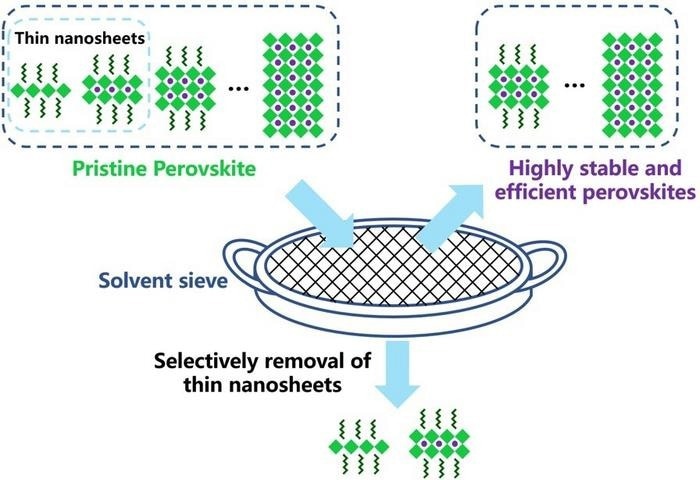Researchers from the Chinese Academy of Sciences (CAS) Ningbo Institute of Materials Technology and Engineering (NIMTE) have led the way in creating record-breaking perovskite light-emitting diodes (PeLEDs) that are stable and highly efficient.

The solvent sieve method for high-performance PeLEDs. Image Credit: Ningbo Institute of Materials Technology and Engineering
They achieved this by using a straightforward solvent sieve method.
The study was published in Nature Photonics.
Because of their superior optoelectronic performance and inexpensive preparation, perovskites are among the most promising optoelectronic materials. PeLEDs exhibit excellent application potential in display and lighting because they have a narrower light-emitting spectrum and superior color purity when compared to conventional organic light-emitting diodes (OLEDs).
Low operational stability, on the other hand, has long restricted the practical application of PeLEDs, even in spite of notable advancements in efficiency. Specifically, the development and commercialization of PeLEDs have been significantly impeded by a lack of understanding regarding the underlying causes of perovskite instability.
The primary cause of perovskite instability was determined by the researchers to be the defective low n-phase of the perovskites after a thorough examination of the fine nanostructures of the material. The quick and chaotic crystallization process was the cause of the low n-phase’s poor quality, which only had one or two layers of lead ions.
To filter out these unwanted low n-phases, the researchers suggested a solvent sieve method, which was inspired by the process of sifting sand of varying sizes.
The researchers claim that polar and nonpolar solvents are combined to create the solvent sieve. Whereas the nonpolar solvent functions as a framework that does not have an impact on perovskites, the polar solvent interacts with them as a mesh. To successfully eliminate the faulty low n-phases, the researchers changed the proportion of polar solvents.
With a brightness of 100 cd/m2, the sieved perovskites used in the PeLEDs allowed them to operate for more than 5.7 years, which is more than 30 times longer than the untreated device. This record lifetime, which surpasses the fundamental threshold for commercial application, is also the highest value reported for green PeLEDs to date.
Furthermore, these PeLEDs significantly increased the efficiency of converting electricity to light, achieving a record high external quantum efficiency (EQE) of 29.5%.
The device exhibits excellent stability, maintaining 75% of its film photoluminescence quantum yield and 80% of its EQE for over 100 days when exposed to ambient air (50 ± 10% humidity).
In addition to greatly enhancing the stability and luminescence of PeLEDs, the solvent sieve method opens the door for the future creation and use of perovskites with distinctive nanostructures and superior luminescence.
Journal Reference
Ding, S., et.al (2024) Phase dimensions resolving of efficient and stable perovskite light-emitting diodes at high brightness. Nature Photonics. doi.org/10.1038/s41566-023-01372-0